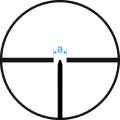Reticle


In terms of weapon technology, the reticle is the marking in the telescope image that enables aiming with the telescopic sight of a firearm . Colloquially it is also known as a crosshair . The reticle can have various designs, from a simple crosshair to a complicated graduation with which one can even estimate distances.
The reticle can be in the plane of the lens or the eyepiece . If it is located in the objective plane of riflescopes with variable magnification, the bars and threads of the reticle grow in the same proportion when the target is enlarged. As a result, parts of the target object can be covered by the reticle. If it is in the ocular plane, only the size of the target object changes, but not the reticle.
variants
- Riflescopes used for hunting usually have reticle no. 1 (see illustration) or reticle no. 4 .
- Modern rifle scopes used for sport , police or military purposes today mostly have the duplex reticle .
- The mildot reticle is also common for military snipers . In this case, small points with a diameter of 0.2 mil are attached at a distance of 1 mil on the vertical and horizontal lines of the crosshairs (1 mil is approx. 1/1000 rad or 3.44 MOA ). The number of points is denoted by MIL. 1 MIL in the rifle scope corresponds to a ZF with constant magnification at a distance of 100 m and a mildot point corresponds to 2 cm (from dot "point"): The mildot thus serves as a measure of length , either to determine the dimensions of an object the distance, or, conversely, the distance measurement given a known (or estimated) dimension.
In the case of riflescopes with variable magnification and the reticle in the 2nd image plane, the sizes only correspond to the respective specifications at a certain magnification. Usually ten times the magnification is given as the dimensionally stable for these riflescopes.
In the case of riflescopes with a mildot reticle and the reticle in the 1st image plane, the reticle is also enlarged and the specified dimensions can still be used.
- Formula : with width and distance in meters
-
Example:
For a police sniper, a 2 m wide vehicle appears 4 MIL wide in the telescopic sight. How far is it
With and and is . The length unit is interchangeable, e.g. For example, an object 1 yard wide that appears to be 5 MIL wide would be 200 yards away.
By vertical and horizontal markings that can Provision when shooting at moving targets and judging distances to improve.
The reticle or parts of it can also be illuminated for use at dusk or on bright nights. This makes recognizing the reticle on the target much easier.
The illuminated dot reticle of the reflex sights is a special form. Here the shooter only sees a (mostly red) illuminated dot in the rifle scope. This reticle allows a particularly fast aiming process and is often used by hunters when shooting fleeing game.
Reticle for hunting purposes
Riflescopes for hunting purposes have illuminated or non-illuminated reticles. The most common reticles are reticle 1 and reticle 4.
The horizontal bars are dimensioned in such a way that at a target distance of 100 meters the center distance (dimensioned with a below ) corresponds approximately to the length of a roebuck (approx. 70 cm). With the A reticle (reticle 4A or reticle 8A), however, the distance is larger, usually twice as wide, so that a roebuck only fills half of the free space at 100 m.
The following reticles are common in hunting:
Quality criteria
The problem of a good and universal reticle can be outlined as follows:
- Good visibility in all conceivable lighting conditions
- The goal should be able to be captured as "precisely" as possible
- The reticle should cover as little of the target as possible
- The goal should be able to be captured as quickly as possible
- The eye should be distracted as little as possible from the elements of the reticle
- The reticle is intended to enable the estimation of distances
- The reticle should allow control over the tilting of the weapon
It is not possible to optimize all of these points in a satisfactory manner, since they are partially mutually exclusive. The decision for a particular reticle depends on the intended use of the weapon and on the personal preferences and habits of the shooter.
See also
- Thread network ("reticle") in eyepieces for measuring or telescopes
- Crosshair eyepiece
- Eyepiece micrometer
- Object micrometers in microscopy
- Circular micrometers in astronomy












